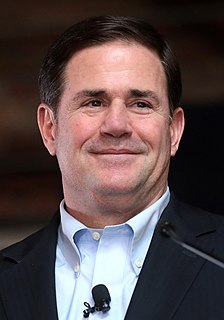It has been requested that the title of this article be changed to List of governors of Arizona . Please see the relevant discussion on the discussion page. The page should not be moved unless the discussion is closed; summarizing the consensus achieved in support of the move. |
| Governor of Arizona | |
|---|---|
 | |
| Style | The Honorable |
| Status | |
| Residence | No official residence |
| Term length | Four years, can succeed self once; eligible again after 4-year respite [1] |
| Constituting instrument | Arizona Constitution, article V [2] |
| Inaugural holder | George W. P. Hunt |
| Formation | February 14, 1912 |
| Deputy | None |
| Salary | $95,000 (2013) [3] |
| Website | www.azgovernor.gov |
The Governor of Arizona is the head of government and head of state of the U.S. state of Arizona. [4] In his role as head of government, the governor is the head of the executive branch of the Arizona state government and is charged with enforcing state laws. [4] The governor has the power to either approve or veto bills passed by the Arizona State Legislature [5] ; to convene the legislature [4] ; and to grant pardons [6] , except in cases of impeachment. The governor is also the commander-in-chief of the state's military forces. [7]
The head of government is either the highest or second highest official in the executive branch of a sovereign state, a federated state, or a self-governing colony, who often presides over a cabinet, a group of ministers or secretaries who lead executive departments. "Head of government" is often differentiated from "head of state", as they may be separate positions, individuals, or roles depending on the country.
A head of state is the public persona who officially represents the national unity and legitimacy of a sovereign state. Depending on the country's form of government and separation of powers, the head of state may be a ceremonial figurehead or concurrently the head of government. In a parliamentary system the head of state is the de jure leader of the nation, and there is a separate de facto leader, often with the title of prime minister. In contrast, a semi-presidential system has both heads of state and government as the leaders de facto of the nation.

In the United States, a state is a constituent political entity, of which there are currently 50. Bound together in a political union, each state holds governmental jurisdiction over a separate and defined geographic territory and shares its sovereignty with the federal government. Due to this shared sovereignty, Americans are citizens both of the federal republic and of the state in which they reside. State citizenship and residency are flexible, and no government approval is required to move between states, except for persons restricted by certain types of court orders. Four states use the term commonwealth rather than state in their full official names.
Contents
- Governors
- Confederate Arizona
- Governors of the Territory of Arizona
- Governors of the State of Arizona
- See also
- Notes
- References
- External links
Twenty-two people have served as governor over 26 distinct terms. All of the repeat governors were in the state's earliest years, when George W. P. Hunt and Thomas Edward Campbell alternated as governor for 17 years and, after a two-year gap, Hunt served another term. One governor, Evan Mecham, was successfully impeached, and one, Fife Symington III, resigned upon being convicted of a felony. The longest-serving governor was Hunt, who was elected seven times and served just under fourteen years. The longest single stint was that of Bruce Babbitt, who was elected to two four-year terms after succeeding to the office following the death of his predecessor, Wesley Bolin, serving nearly nine years total. Bolin had the shortest tenure, dying less than five months after succeeding as governor. Four governors were actually born in Arizona: Campbell, Sidney Preston Osborn, Rose Mofford, and Babbitt. Arizona has had four female governors, the most in the United States, and is also the only state where female governors have served consecutively. [8] Because of a string of deaths in office, resignations, and an impeachment, Arizona has not had a governor whose term began and ended because of "normal" election circumstances since Jack Williams was in office, from 1967 to 1975.

George Wylie Paul Hunt was an American politician and businessman. He was the first governor of Arizona, serving a total of seven terms, along with President of the convention that wrote Arizona's constitution. In addition, Hunt served in both houses of the Arizona Territorial Legislature and was posted as U.S. Minister to Siam.

Thomas Edward Campbell was the second governor of the state of Arizona, United States. He is the first Republican and first native-born governor elected after Arizona achieved statehood in 1912.

Evan Mecham was an American businessman and the 17th governor of Arizona, serving from January 5, 1987, until his impeachment conviction on April 4, 1988. A decorated veteran of World War II, Mecham was a successful automotive dealership owner and occasional newspaper publisher. Periodic runs for political office earned him a reputation as a perennial candidate along with the nickname of "The Harold Stassen of Arizona" before he was elected governor, under the Republican banner. As governor, Mecham was plagued by controversy and became the first U.S. governor to simultaneously face removal from office through impeachment, a scheduled recall election, and a felony indictment. He was the first Arizona governor to be impeached.
The current Governor is Republican Doug Ducey, who took office on January 5, 2015.

Douglas Anthony Ducey is an American businessman and politician who is the 23rd governor of Arizona. A Republican, he was sworn in as governor on January 5, 2015. He was the state's treasurer from 2011 to 2015.






















































